I Entry Points
“What is going on? End of the world? Advent of another world?” The words are spoken by a middle-aged man sitting near a pier on Lake Geneva, as he leafs through a book of reproductions of the Franco-Russian artist Nicolas de Staël, after a sequence of shots that might well have engendered these very questions. A title card with the numeral ‘2’ superimposed upon (and literally floating above) the legend ‘LA MÉTAPHORE’ flashes by; followed by a poor quality, tightly framed, tilted black and white shot, in slow motion, of a man swimming to the cheers of an unseen crowd (appropriated footage from Boris Barnet’s By the Bluest of Seas [1936]); succeeded by a medium shot in garish colour, panning right, of an armed African soldier herding a group of young African men in front of an all-consuming conflagration of fire and strobic intimations of hovering helicopters; interrupted in turn by an incorporated snippet from Jean-Pierre Melville’s adaptation of Jean Cocteau’s Les Enfants terribles (1950) in which Elizabeth talks to Paul about grasping ‘the end’ in a melodramatic tone then regards the camera directly with a terrible knowingness; but this in its own turn gives way to a medium shot of a mongrel bitch wading in a riverbank and nibbling at the grass growing there in green profusion, a jittery hand-held shot suddenly suspending us in the depths of three-dimensional space and reminding us that the previous three ‘quotations’ have been flat and compressed; a reminder now made stark by the appearance of yet another shot, in extreme slow motion and quite out of focus, of a man reaching out his right hand at us and waving his fingers hypnotically – a direct auto-reference to the alarming invasiveness of certain 3D effects, and their occasional stupidity. Two title cards on black backgrounds next appear, one reading ‘OH’ in red, the next ‘LANGAGE’ in white, preceding a shot at eye level of a ferry flying a French flag approaching a pier on Lake Geneva. It is now that we cut to the jerky hand-held shot at a roughly 30-degree angle, and taken as if from the place on the bench next to him, of the man in trench coat and fedora who speaks: “What is going on? End of the world? Advent of another world?”
The several shots are all fairly brief in length – the swimmer commands ten seconds, the African war scene only two, the Melville appropriation twelve, Roxy (for it is she [1] ) five, the hypnotist eight, and the establishment shot at Lake Geneva nine – and oblige us, in their stark concatenation, to work quickly with what we are given, or else drop our guard altogether and surrender to the sequence as a fait accompli. But what would such work look like, if we were prepared to accept it? “What is going on?” is not an unreasonable question to pose, after all, and the latent but inescapable sense of some looming apocalypse – “End of the world?” – is part of the troubling energy of the sequence, since, taken in that sense, the desperate efforts of the swimmer, the military catastrophe in Africa, and the awful regard of Elizabeth into our very souls, all trigger a dark foreboding and mounting affective urgency that the next shot, of a wading Roxy in the bosom of Nature herself, seems to conjure away – “Advent of another world?” – while the mysterious hypnotist then hangs the question in some obscure balance, doubtless associated with the medium of cinema itself, in which we receive these fragments as encrypted messages in a bottle.
A first point is that, of course, this is a transitional sequence, ushering us out of the first section of this film Adieu au langage (Goodbye to Language, 2014), as the title card reading ‘2’ indicates, and as its subtitle ‘LA MÉTAPHORE’ also insists. That first part, entitled ‘1, LA NATURE’, is thus retroactively to be construed as a bedrock of reality or fact, on which this second part will poetically elaborate certain figural repetitions and differences-in-identity. Here, the ‘2’ arrives to unsettle the self-evident closure and immanence of the ‘1’ by positing a tropological energy that turns self-evidence upon itself. We are thus cast back, if our memories will allow us, to the initiating sequence of the first part, another montage, presented before the section title card and right after the opening credit sequence: an oversaturated couple of shots taken from a Western war film (bombs detonating, machine gun fire, etc.); followed by two shots from a classic Hollywood comedy, in which a blonde discovers some small object (a coin?) and shouts out “Hey! Hey Jeff!” in raptures through a curtain of rain; followed again by a close-up of Roxy, now indoors and in extreme slow-motion (with the interpolation of two extreme, zooming close-ups of an oil on canvas painted in thick black strokes). The relationship of our ‘metaphorical’ sequence to this earlier one is both clear (old black and white movies, colour war footage, Roxy the bitch, all in common) and opaque. In each case, the montage of found footage alongside material shot specifically for this film generates a kind of poetic unity, in which sexed couples are separated, facing some kind of crisis, associated with the most extreme technicolour violence, and positioned in relation to a third element (a canine creature) whose ability to suture the antagonistic space remains in doubt (thus the hypnotist, and the thick black impasto). But this only becomes truly clear because the ‘metaphor’ repeats ‘nature’ without repeating it. Differences relate: the dog was indoors, but now is at the riverbank; the blonde was ecstatic, but now is doom-laden; the war was European, but now is African; water fell in sheets, but now forms an element through which one must swim.
Second, however, one cannot avoid the conclusion that, no, our unassisted memories will not allow us to make these connections after all. The ability to hold together in the mind one 30-second montage sequence against a 40-second sequence appearing ten minutes later, such that these inner harmonies and dissonances become apparent and meaningful, does not belong to a human being sitting in a cinema. Instead, the phenomenology of cinematic perception tends to slip through these streams of seemingly heteronomous particulars, seeking those more reliable narrative anchors of characters, plots, and legible spaces – which duly, if rebarbatively, come. What remains is a blur of latent information that we swiftly label ‘subliminal’ even as we are watching it, dimly accepting of the fact that deeper psychological connections (not only “their constellations, the patterns of similarity and difference which they form as they come at us in clusters,” [2] but between those clusters themselves) will have been made without our particularly attending to them, or therefore being conscious of them. I want to describe this as a willing suspension of hermeneutic anxiety, without which no recent work by Jean-Luc Godard is parsable on first encounter, and which obliges us in the name of aesthetic responsibility to return – if we have been touched at all by the greater logic of the work – sometime later and begin the patient task of reconstructing the nexus of molecular interconnections out of which the film is, at all points, woven. There is, in late Godard, only ever a second, a third, a fourth viewing; since the first, the One, is never experienced as properly identical with itself to begin with. It is so fractured and atomized in certain passages, so irreducible to any singular horizon of sense, that without the willing suspension of hermeneutic anxiety we are proposing here, it cannot be persevered with and is abandoned prior to its conclusion. In a word, what I am suggesting is that, at least since Éloge de l’amour (2001), it is virtually accepted that the cinema is no longer the proper place to experience a Godard feature, and that we viewers are tacitly inveigled to mimic in our own comportment and habits, our attitude and patience, the artist himself: seated at his workstation before a monitor with a digital file open before him, that he can scroll back and forth at will.
In that sense, “what is going on” here is that very old and enduring habits of cinematic perception are being challenged at their foundations. It is not enough, and has not been enough since that epic of testimonial self-objectification that is the Histoire(s) du Cinéma, to rely upon the phenomenological ruminations and retentions of even the most careful cineaste to vouchsafe the innumerable linkages that a Godardian work makes possible by virtue of its meticulous logic of construction. At its limit, that logic has been characterised as an insistence on “making each shot independent and giving it the power to enter into an indefinite number of relations with all sorts of fragments of other films, paintings, photographs, texts, sounds, etc.” [3] – an aesthetic of radical fragmentation, appropriation, and autonomization that exceeds the capacity of any individual, given that the cinematic medium remains temporal and unilinear, like music. Indeed, the musical analogy is somewhat appropriate, given the descent into smaller and smaller units – phrases, motifs, and tones – in keeping with the reification of listening habits that Adorno long ago theorised via the music of Richard Wagner and Gustav Mahler. [4] But whereas in music there exists a kind of musicological literacy that makes the inner form of even the most radical, serial compositions evident to the trained ear, for cinema no such literacy exists – although it once may have seemed to do so. In the heyday of cinéphilia, and under the tutelage of artists such as Godard, dreams of a language of the medium prospered, and the art was subjected to all the analytic paraphernalia of the ‘linguistic turn’ in order to elucidate the deepest patterns and grammar of the cinematic langue itself. But what good after all is language to this medium, as analogue or metaphor? The human being cannot ‘speak’ cinema the way she can hum a tune. Musical form, for all its vast inner complexity, at least remains within the bounds of notes, rests, rhythms and harmonies; but cinema is too heteroclite, too composite, too “subtractive” a medium in relation to the other arts and media to ever stabilise into an underlying code. [5]
Today it is resolutely a case of goodbye to language, a valediction that is paradoxically also a goodbye to cinema. And that farewell is, at one and the same time, a hailing of an altogether newer medium, made not of silver halide crystals, celluloid strips, Maltese crosses, and silver screens, but of infinite lines of code, strings of 1s and 0s, on which this particular Adieu au langage will have been recorded, mixed, edited, distributed, downloaded and projected after all. For it is only as a searchable file, not a roll in a can, that such a work can properly reveal its aesthetic protocol to us, and only insofar as we assimilate and imitate the formal lessons of its author, who has for two decades been provoking us to treat film form the way Walter Benjamin understood the form of his Passagenwerk: a text whose ultimate fate should have been to be composed of nothing but quotations from others, the author’s ‘voice’ heard only implicitly in the plate tectonics undergirding the slabs of imported utterance. Indeed, it is precisely as a book – that singularly reversible form, linear when it is being read aloud, but available for patient toing and froing by the silent reader alone in her study – that Adieu au langage asks to be understood, a textual form both in and outside the flow of time. As such it has two cohabiting architectures: One – the cinematico-phenomenological flow, in which we avail ourselves of the willing suspension of anxiety; and Two – the archival arrest and reversibility of that flow, its folding back upon itself, in which we internalise the aesthetic praxis of the auteur. A One and a Two, a nature and a metaphor, a literalism and a poetics.
II USINE
Books feature largely, as they generally do in Godard, in the opening section ‘LA NATURE’, where this same man, a Mr. Davidson (Christian Gregori), now in a dark suit and tie, holds something like his street office hours outside the Usine à Gaz cultural centre in Nyon, Switzerland. His desk is bestrewn with them, and young men and women (his students presumably) as well as an older woman (perhaps his partner), pick them up, leaf through them, put them down again. He himself is reading Aleksandr Solzhenitsyn’s The Gulag Archipelago, and a young red-headed woman picks up in quick sequence Fyodor Dostoevsky’s The Possessed, Emmanuel Levinas’ The Time of the Other, and Ezra Pound’s fascist collection Work and Usury, while on the table we make out Robert Pobi’s L’Invisible. It is an accent on the literary, and on published material, that will be taken up variously later in the work, as in the book of de Staël reproductions and the culminating recreation of the writing of Frankenstein; and which carries a mass of associations across Godard’s long career. From Jean Seberg’s interview with Monsieur Parvulesco (Jean-Pierre Melville) in Breathless (1960), through the random quotations from a mountain of indifferently assorted books in 2 ou 3 choses qui je sais d’elle (1967), or the books read in bathtubs by Brigitte Bardot (Le Mépris, 1963) and Jean-Paul Belmondo (Pierrot le fou, 1965), on down to the conference on literary encounters in Notre musique (2004) – featuring guest appearances by Juan Goytisolo and Mamood Darwish – by way of the monumental personal libraries of the Histoire(s) du Cinéma (1988-1998) itself: no filmmaker in history has framed so many books, so lovingly, both as substantive components of the mise-en-scène, and as source texts of so many of the lines passing for ‘dialogue’ or ‘voice over’ in the diegesis itself. Here the pointed attention to a forgotten book by Pound is on topic, since Pound was the first to master a method central to twentieth-century poetics: the incorporation of the found document, text cribbed from other sources without modification but shorn of context, and recycled as material in the poem materializing as a result.
The scene, however, is mounted to score some rather cheaper and polemical points about the fate of text and mentality itself in the digital era, since everybody is holding and communing with their smart phones, even as the literary material graces the screen with a somber beauty inherited from a distant epoch. It is a situation that Davidson appears resigned to, since he asks bemusedly what the subtitle of Solzhenitsyn’s masterpiece might be, quickly adding that there’s no need to Google it – the author came up with it all by himself. The answer to his query, which he provides himself (and is echoed a little later by the inevitable, belated Google search he had declared unnecessary), is encouraging: “experiment in literary investigation.” It connects us back to the Poundian subtext, and the two-tiered reading strategy explored above: an investigative method predicated on literary experimentation, which is to say, the abandonment of fixed forms and the acceptance of paratextual cannibalization and recycling as legitimate devices. He wonders, too, what the thumb used to do before all this touch-screen typing and swiping (apparently ignoring its role in turning pages, even as he does it himself), and the question digs deep into the phenomenological and technical apparatus of literacy itself – since not only will the culminating sequence show us Mary Shelley gamely pressing a goose quill between thumb and forefinger as she slowly scratches the words ‘misery – sadness’ in her Frankenstein draft notebook, but gestures cryptically at the odd fact that the very name we have chosen for our computational hegemon – the digital – refers explicitly to the fingers of the hand. Goodbye to language indeed: in the teeth of its rejection by or sublation in code, it has a stubborn way of creeping back into the analytic frame.
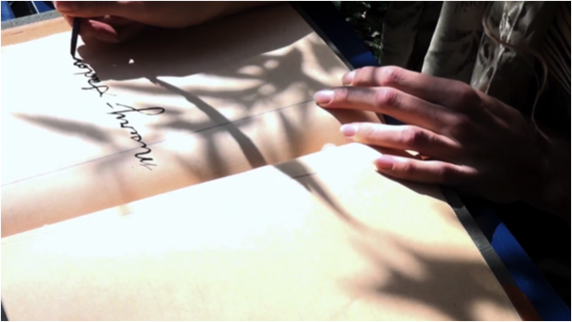
Never so illustratively, indeed, as in the film’s longest series of quotations from a single text, the several minutes given over to passages from a posthumous collection by Jacques Ellul (1912-94), L’homme qui avait (presque) tout prévu [The Man Who Foresaw Almost Everything], compiled by journalist Jean-Luc Parquet in the last years of the twentieth century, in which Ellul’s uncanny predictions seem to have laid bare the essence of late capitalist technocracy avant la lettre. This prolonged suite of excerpts, read in voiceover by a woman (and by Davidson himself, onscreen to camera), begins in one of this work’s many cuts to a black screen (there are a dozen in this chapter alone, ranging between two and twenty-seven seconds in duration) and emerges from an anecdote about Zworykin the Russian inventor of television in 1933 (“Does 1933 ring a bell?” Davidson asks with Adornian grimness) and a piece of found footage of Hitler in that year of his electoral victory. It binds together the several minutes that follow, which involve our first monochrome introduction to the woman who unifies the NATURE sections of the film – Josette (Héloïse Godet) – in brooding close-up, and two extraordinary suturing shots in which the acousmêtre of this ongoing recitation is grounded, not in a body, but in Davidson’s iPhone, which he at first reads from and then reverses to show the cover of the Kindle edition he has used to find it on a website.
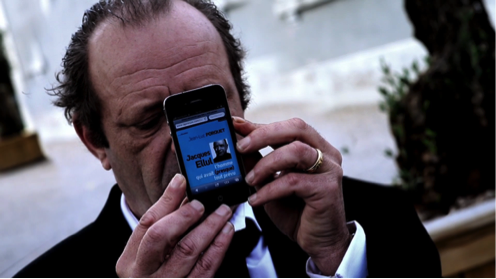
The moment is crucial for several reasons, not least the fact that here our Godard figure (though the auteur himself appears at the very end, off-screen, an acousmêtre himself) willingly cites a source for one of his copious plagiarisms, albeit deviously by way of the very medium this scene has established as antithetical to the culture of the book. The Googling of Ellul conjures the very stream of utterance we hear, a series of bracing observations about the State, technology, social control, and alienation, over which Davidson pronounces his précis of the volume itself [I place in square brackets the continuity of the female voiceover quotations from the text]: “He saw it all coming. Almost. Atomic power, GMOs, advertising, [The State takes all] nanotechnologies, terrorism [This is Hitler’s second victory], unemployment…” This is the first time in a Godard film that a text has been ‘read’ not from its printed format as a codex, but from its digitized version, and in a context where the form is explicitly matched to the content. Ellul’s prophecies and warnings typically took the theme of the increasing technologisation of our way of life as a threat to liberty: “Modern technology has become a total phenomenon for civilization, the defining force of a new social order in which efficiency is no longer an option but a necessity imposed on all human activity,” he wrote, a sentiment that chimes with the robotic iPhone and Android usage throughout the scene. [6] Hitler’s second victory? Things stand more ambiguously than that, since the perceptual triage effected by the shots of Davidson’s phone (linking voice to instrument to text) is aesthetically satisfying in a way that doesn’t immediately suggest totalitarianism – though, to be sure, echoes of Eisenstein’s observations on montage and the sound film are felt in a sinister undertone. Nor could a work of art entirely put together via these same machines afford simply to impugn its very basis in material and mediatic reality. So the framing of the shot is canted, at a curious angle, as if to suspend its authority over a certain question mark; and it is prepared for by a startling still image, in darkling monochrome, of the same composition.
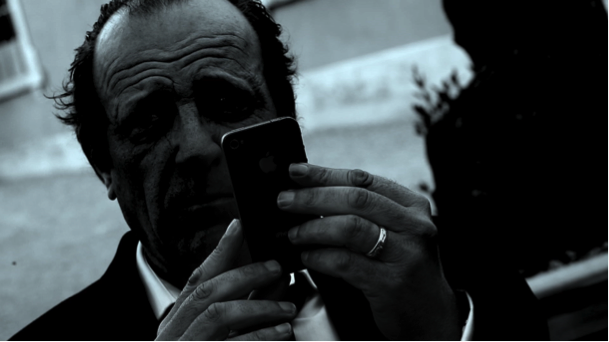
It is an image of ‘grounding’ if ever there was one, openly melancholic in tone: those big, feeling hands cradling such an improbably small and ridiculous object; that furrowed brow concentrating on pixelated typefaces lambent on the unseen screen. When you put a smartphone where a book should be, you show a “necessity imposed on human action,” but you do so with a machine genetically indistinguishable from the ridiculous object itself, and you are part of the problem you are diagnosing.
That all this takes place just outside the premises of the Usine à Gaz – or as the signage out front puts it more decisively in boldface, ‘USINE A GAZ’ – adds various layers of irony and complication to an already dense cluster of meanings. For while the facility may well be housed on the premises of a disused nineteenth-century gas factory (not strictly speaking a manufactory but a place of storage for oversized gas tanks), Godard is surely angling for a richer seam of connotations than the postindustrial as such. The phrase itself lingers in French parlance, not as a place name, but as a trope generally used to disparage new initiatives in bureaucracy and governmentality that appear showy and complicated and costly, but which tend to deliver much less than they promise. So a ‘usine à gaz’ is something like a Rube Goldberg machine or Heath-Robinson device, a kludge or white elephant: a uselessly elaborate system yielding less than the sum of its parts. Its ambiguous relation to Davidson’s work here (he speaks of an exam, and mentions the vacation period before classes recommence in September) nicely keeps open the question of the relation between the education system and the culture industries themselves – an association that is overdetermined by the inevitable pun in ‘gaz’, since ‘gaze factory’ is how Godard tends to characterize national film industries, Hollywood above all, the infamous ‘usine à rêves’ itself. Moreover, cinema’s longstanding association with factories dates precisely from the inaugural ‘actualité’ of Workers Leaving the Lumière Factory (La Sortie de l’Usine Lumière à Lyon, 1895), in which Lumière workers exit the gates of the first cinematic ‘factory’ in Lyon, here rhymed elegantly by the Swiss town Nyon, where the scene is set. As Harun Farocki has memorably shown, the cinema has not ceased to rethink and refashion this first ever shot; his masterly installation for 12 monitors, Workers Leaving the Factory in Eleven Decades (Arbeiter verlassen die Fabrik in elf Jahrzehnten, 2006), and the earlier film essay out of which it grew, Workers Leaving the Factory (Arbeiter verlassen die Fabrik, 1995), demonstrate something like an obsession that is also a repulsion internal to the medium. That same dynamic could be said to apply to Godard himself, who, drawn for political reasons to factory spaces (think only of Tout va bien [1972]), still finds it difficult to configure human relations in an actual industrial setting, as Farocki himself has complained apropos of Passion (1980): “It’s a pity that he can’t prove his point by showing machine work rather than naked women. All the old prejudices against filming inside industrial spaces are confirmed, even as they are deplored.” [7]
At any rate, this is a factory become a ‘cultural centre’, in a spatial symptom typical of the postindustrial phase of late capitalism, and the people milling around its entrance are relatively well-off intellectuals, not workers; it is the middle of the day, and nobody appears to have a job to attend – although of course the vacation period is mentioned. Not labour but leisure is the dominant mood here, and the freedom to debate books and ideas seems implicit in the prototypical Godardian mise en scène: chairs, desks, people, books, a streetscape, table umbrellas, all disposed so as to encourage aimless encounter and discussion. But then arrives the inevitable gun, attracted to the inevitable girl, and the plot kicks into gear with a flash of confrontational violence and an off-screen gunshot; all the book-lovers scattering to the winds so that she – Josette – can be singled out by the German husband in the dark Mercedes. This sudden transfiguration of the coordinates is a quintessential gesture for an artist to whom plot is always a mere contrivance, albeit one that he can scarcely do without. Just as one felt the gravitational tug of Hollywood genres and narrative orthodoxies on the relative anarchy of Godard’s New Wave films, and registered it with a mixture of irony and relief, so here (and throughout late Godard), the intrusion of narrative in all its vulgar stereotypicality impresses its anachronistic ‘movement-image’ logic on an otherwise momentumless, but far from unpleasant, ‘time-image’ governed by literary interiority and reflection. That the action seems borrowed from one of those same 1960s New Wave films (dark car, pistol, a tug and a yell, shots fired) is doubtless the point: Godard inveterately referencing his own notorious quip about the gun and the girl in order to attach his authorial signature and reassure the base, in what must ultimately be a law of diminishing returns.
But this is as much as to say that plot itself, put crudely, is nothing more than a usine à gaz, which said in another tongue means simply, a MacGuffin, or something whose exterior appears fascinating and complicated, but which is empty on the inside. The ‘gas factory’ or ‘gaze factory’ is one where the MacGuffin will always be superadded to the network of images, to initiate a narrative drive that will have been, since D. W. Griffith, cinema’s deathless curse inherited from literature itself. “Godard’s narrative,” writes Jacques Rancière, “of a lost battle of the cinematographic image against the power of text and plot – that is, the power of Industry and Capital” takes place precisely at the gates of the usine à gaz itself, but its results are less categorical than Rancière wants to make out. [8] Perhaps in that sense the ubiquitous handheld digital devices, for all their tendency toward social conformity and new modes of ‘necessity’ in the habitus, gesture outward, away from plot mechanics, and toward the horizon Godard has always instinctively preferred to the narrative regime, namely the network as such – which they positively instantiate and emblematize. For these devices know no emplotment, only a 4G connectivity that disperses the materials outside of the cinematic frame. It is worth remembering that another use of the phrase usine à gaz was to describe, in the late 1950s, the massive, 30-tonne, 500 square metre monstrosities that were the earliest processing computers – of the sort that govern the bureaucratic worlds of Alphaville (1965) and Jacques Tati’s PlayTime (1967), and give substance to the hypotheses of Ellul. That the lightweight devices we see in the hands of Davidson’s entourage can each of them outperform by several factors of speed and power one of those dinosaur ‘gas factories’ of the recent past, is part of the constitutive irony of this scene. They represent, as well, the colossal Foxconn factories in China where they are assembled in conditions almost unthinkable on Lake Geneva, thus adding an Asian and industrial element to this work’s more pointed emphasis on Europe, Africa, and the USA (Asia having, relatively speaking, fallen off Godard’s psycho-geographical map after Vietnam).
Transposed into the region of ‘MÉTAPHORE’ in the film’s second section, the usine has disappeared (we seem to be situated further along the ferry route, in the town of Rolle), the dark suit has been replaced by a light trench coat and black fedora (which the metaphorical girl, Ivitch [Zoé Bruneau], also wears, in a winking tribute to Alphaville – the actors even bear passing resemblances to Eddie Constantine and Anna Karina), the dark Merc now a paler colour (and shot upside down!) – but the actors playing Davidson and the German husband are the same, as is the violent shake, the gunshot off-screen, and the same young couple from outside the usine reappears, emigrating to America to spread ‘philo’, or dated French philosophy (the boy quotes Jean-Paul Sartre, of all people) to the Philistines. In a word, while the network of images has shifted perceptibly, the narrative regime works to equate the dissimilar within a hegemon of equivalence, whose name is Capital (the Merc, the trip to America, the iPhones, the ‘philo’ for sale, all signatures of this dominion). Metaphor is here a gesture of displacement along a limited chain, allowing for two new actors to assume the roles of adulterous wife and lover (as they will throughout the paired midsections of the film), but without troubling the narrative Procrustean bed in which they are obliged to live out the same destinies, speak the same lines, and make the same gestures. This is a now well-established device that we have seen developed in the works of David Lynch (Lost Highway, 1997, Mulholland Dr., 2001, INLAND EMPIRE, 2006), Todd Haynes (I’m Not There, 2007), Todd Solondz (Palindromes, 2004), and others: different actors, same parts. But if Ivitch is to Josette as metaphor is to nature, what does this troping make possible for an aesthetic act manifestly disinterested in character as such? As Ivitch says bitterly, changing clothes while she watches Rotwang menace Maria in black and white on her flatscreen TV, “I detest characters. Ever since birth, we’re mistaken for another. We push him, we pull him, we force him to get in character.” It is another usine à gaz, this coercive and systematic misapprehension called character, far more trouble than it is worth. But what lies on its far side?
III 0, 1, 2, 3
The black screen, a frequent punctuation mark throughout this work, is a kind of visual null point, not exactly a cinematic cipher, since the voiceover comes into peculiar aural focus at these moments, but an erasure of plenitude and a clearing of the slates. I want to describe it as a visual zero dimension, since here the eye has nowhere to go, while what the Romantic tradition called the ‘inner eye’ is liberated to make its incursions on the non-visualisable totality that these blank frames conjure by way of a negative dialectic. “You mentioned murder,” Davidson replies to Ivitch at one point, with the de Staël spread out before them. He then paraphrases Guy Debord at his most Hegelian: “What they call images are becoming the murder of the present.” The task of liberating the present (“a strange beast,” as Ivitch muses) is left to these black frames, empty calling cards of the negative. But who is left to liberate anything? Not, to be sure, the individual or his vaunted subjectivity, since as Davidson quotes Philippe Sollers in a late interview, “Interior experience is now forbidden by society in general, and spectacle in particular.” Images are what evacuate interiority; all the former literary depths and resources of a body gripped and hollowed-out by language are now flattened into a plenum of equivalent visual signage. So the black screen suggests a figuration of, at one and the same time, the void of inwardness under the spectacle (the ‘no-world’ that comes with late capitalist network society), and the end of the regime of images itself: a neatly knotted dialectical fold. It poses the profound aesthetico-philosophical question: how does one present the void, conjure an image of what is imageless and featureless? And so it enters into a dialectical relationship with those haunting, close-up, hand-held images of the hills and valleys of black paint swirled onto a canvas.
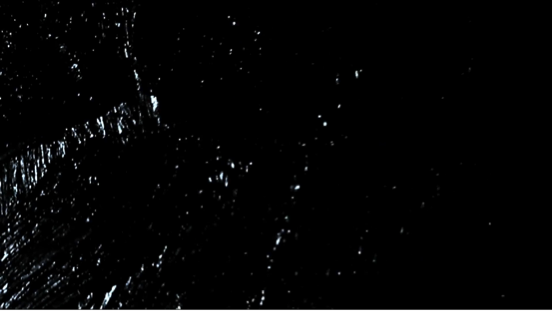
This is that ‘dark continent’ of the senses and the psyche of which positivist philosophers despair, and it chimes fatefully with the repeated question, asked by both Josette and Ivitch (who are quoting Jocelyn Benoist, herself quoting Salim Abdelmadjid): “Is it possible to produce a concept of Africa?” [9] Freud hesitated at the same point before the enigma of ‘woman’; a conceptual void located at Conrad’s ‘heart of darkness’ where ideology turns to myth and barbarity. Colonialism and patriarchy dovetail in this void, but the void is also, and more potently, the site of a thoroughgoing conceptual dehiscence.
Yet it is only because, at other moments, the black screen is punctured by a single white point – or at least a disk or small circle that we will take to be iconic of a point (itself, like the totality, unrepresentable on the screen) – that this zero dimension realizes itself retroactively; as if only the most minimal difference, a single point, can truly conjure the void out of a black space. These moments are critical for further establishing what I will now want to call the ‘one-dimensional’ space that this work associates with Marcuse’s thesis on one-dimensional man and the various resonances between that work and Ellul’s.
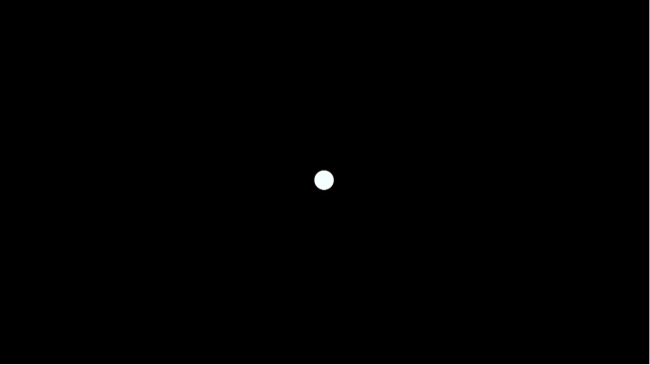
The gesture is rhymed by a repeated quotation of a scene from Robert Siodmak and Edgar Ulmer’s People on Sunday (1930), which Godard plays at stop-motion velocity, featuring a woman playfully outrunning the pursuit of her lover in a woods, succeeded by a cutaway to an image of the moon in a cloudy sky:
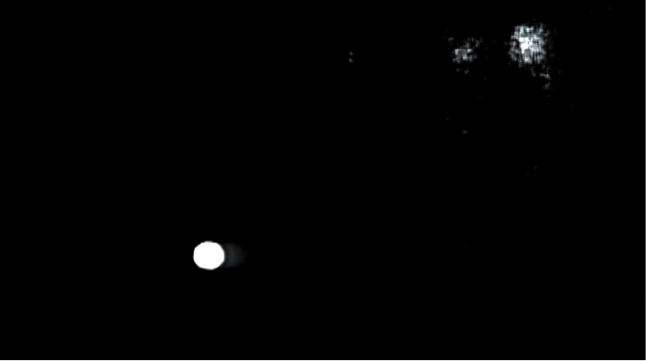
What is more, there is a brief shot of the canvas covered in black oil paint taken as a brilliant highlight glistens in one of the peaks of the wet, textured surface, which again makes the same visual point:

This repeated emergence of a point from the zero-dimensionality of the Black as such is the best stab an audio-visual artwork can make at the first dimension: a dot available to become a line, in any direction whatever. The point, the mark, the single space, is what convokes the One as a principle, over and against the void; and thereby establishes a constitutive relationship with Godard’s understanding of the State. In Film Socialisme (2011), Godard treats us to a seminar aboard the Costa Concordia, presented to an empty conference room by none other than Alain Badiou (a major source for Adieu au langage as well), on the redoubtable topic of geometry. “Geometry as origin, the origin being what we always return to,” Badiou drones. “We have been witnessing in the past few decades, notably in mathematics, a return to geometry.” Edmund Husserl’s essay “Origin of Geometry” (1936) was a pivotal stimulus for the post-structuralist turn in the 1960s, under the impetus of Derrida’s studies into that same volume. But perhaps more importantly still, the ‘geometrification’ of visual arts in the 1910s and 20s (think Cubism, Mondrian, Rodchenko, El Lissitsky, and many others), was one of the more palpable symptoms of what Badiou has called, in another context, the twentieth century’s ‘passion for the real’ [10] – since in such gestures, the arts cut their moorings in the merely phenomenal world, and set adrift upon the Absolute. Godard’s emphasis on the point as the ‘origin of geometry’ rejoins a century’s worth of meditation on these questions, but hitches it as well to the matter of what Badiou calls the ‘count-as-one’, the representational decision as to what should, and what should not, constitute an effective situation or state of affairs – at the cost of the infinite multiple remainder that all such operations must inevitably foreclose. For Badiou, however, the One is always a product of the multiple, not the reverse: “What has to be declared is that the one, which is not, solely exists as operation. In other words: there is no one, only the count-as-one. The one, being an operation, is never a presentation.” [11] There is no One that is not a forcible decision to delimit the manifold, and all such decisions are a work of mathematical fiction or geometrical foreshortening. The most important of these states of affairs, politically speaking, is the State itself, a One perpetrated upon the boundless multiplicity of beings and languages and territories, ad infinitum, that make up a ‘nation’.
It was against this entity, this terrible count-as-one, that Godard’s generous appropriations from Ellul had been particularly ranged: “we are raising the totality of the nation against us,” the voiceover quotes. “We’ve become used to the State doing everything and as soon as something goes wrong, we make the State responsible. We ask it to take the nation’s life entirely in its charge.” Such systematic alienation of the individual rights of decision and responsibility to an abstract organisational fiction, which is constitutive of modernity as such, is for Godard, for Ellul, for Marcuse, and for Badiou, the very worst the One has done to us, existentially, politically, and aesthetically. For in this bondage to the overarching principle of ‘static’ unity, we have abrogated our claims to participatory democracy, to ethical responsibility as a way of life, and to the clamour of the multiple that every artwork presents us with as its most radical offering. To Godard in particular, the State, as representative of the dark shadow of the One cast over all life, making us all ‘one-dimensional’ people, is held in the lowest possible esteem. Drawing his deepest animus from the writings of Georges Bataille, Godard has repeatedly invoked an antagonism at the heart of modern experience, not between the void and the One, but between the One and the Two: “The antithesis of the loved one is the state whose sovereignty takes precedence,” as Éloge de l’amour puts it. While the State nurtures the One, love hatches the Two. It is a paraphrase that has been invoked repeatedly in the films since. Bataille wrote, “Actually, if we love a woman nothing is further from the image of our beloved than the image of society or, a fortiori, of the State.”
Of course, we may object to a way of looking at things wherein it is not the global union (fusion) of all individuals in the State that represents the universal in us, but rather the couple, in which the object is reduced to what is most heavily particular in the world, the individual; where the fusion of this object with the subject always has a transitory character (whereas in the State the individuals, not their union, are transitory). But the State never means the totality to us. [12]
It is Godard’s very credo. The State’s One, a coercive fiction, fuses the multiple into a sovereign power that never means the totality to us. But the woman, introducing a rupture into the corporate unities of public life, convokes the only true universality it is given us to feel: the couple.
So it is that a second dimension, painfully wrenching itself from the first, discloses the domain of love and of the couple, of the image, and above all of woman. Nothing is more familiar in Godard than the odyssey of the Two in all its many phases: meeting, separating, reuniting, intuiting a commitment, forging a bond, hazarding a fidelity, launching a project, entering into a crisis, experiencing betrayal, relapsing into boredom, fostering contempt, recrimination, and departure. These are the several seasons, or the stations of the cross, through which the couple is put to the test, time and again. And the test is always the same: love is not to be conceived as an end in itself, but as a medium through which to execute the project that this couple makes possible for the first time. It is a test universally failed in Godard, and with good reason – the test is severe and uncompromising. Slavoj Zizek has summarized its ethics:
The underlying paradox is that love, precisely as the Absolute, should not be posited as a direct goal – it should retain the status of a by-product, of something we get as an undeserved grace. Perhaps there is no greater love than that of a revolutionary couple, where each of the two lovers is ready to abandon the other at any moment if revolution demands it. [13]
The two couples in Adieu au langage, themselves the products of former betrayals, are mired in the same phase of boredom and set on the threshold of contempt. They are physically trapped in their small house (it is the same domicile in both scenes), through which they wander mostly undressed but never aroused, hemmed in by the paraphernalia of Dutch still lifes (bowls of fruit, vases of bouquets), of furnishings and appliances – like any other bored middle-class couple in terminal decline. ‘He’ is in both cases a cloacal Democritus, seeking with a mirthless laughter to traduce every idea, every metaphor, in the same excremental stream that Farocki and Kaja Silverman once distilled out of Godard’s Week End (1967):
In late capitalism, the commodity quickly gives way to “waste.” The supremacy of economic over other forms of value leads to a dramatic diminution in the kinds of value any thing can have. It also leads to a decrease in the amount of value a thing can have. … There can no longer be absolute value, only objects for which substitutes can quickly be found. With this serialization of the exchange process, the moment of enjoyment of each new commodity also becomes briefer and briefer, so that it passes for this reason as well as much more quickly into the category of “shit.” [14]
So it was in 1967, so it is today, only more so. As ‘he’ sits endlessly on the toilet, defecating and farting stereophonically while she waits to get in the shower, he detains her with his vision of all concepts returning to ‘caca’. Gouts of blood spatter the white bathtub. His ‘pro-sequent’ murder in a public pond is rendered synecdochally in a garish visual rhyme with the one-dimensional slides, and a gesture to the hole/anus he represents:
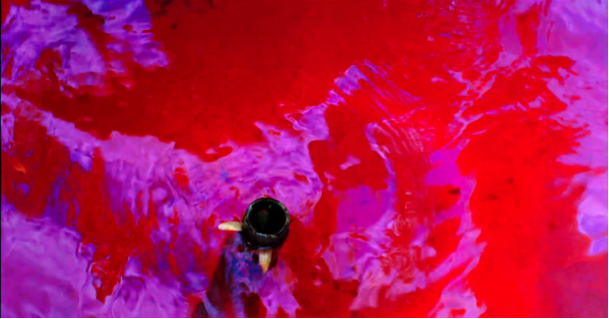
Nor is ‘she’ in any better situation to redeem the lost truth of the couple. Though she may not have descended into excremental cynicism, she has succumbed instead to that most typical of the late-Godardian feminine temptations: the death drive. The tutelary figure of Simone Weil works through these later films as a latent destiny for the woman unable to feel love, and sure enough, both Joestte and Ivitch outline a broadly suicidal ethics, predicated on a vision of the universe from which love has been fatally subtracted.
The couple is thus framed with unease and disquiet, always on edge and generally canted at 30 degrees or so:

Moreover, the camera is rarely to content to sit still while the simmering tensions play out; extraordinary rolls across the horizontal plane occur, tilting us over, inverting us, so that the veil of the ‘still life’ aesthetic is lifted with a properly cinematic violence. The sound appears to have been recorded in camera, tinny and distant, with too much incidental noise crackling across the dialogue (and outdoors, the absence of a muffled microphone leads to fiendishly amateur soundscapes). Indeed, proper stability only comes in those allegorical tableaux, tethering metaphor to nature, where tracking shots right finally carve out a properly two-dimensional space for the couple in front of a two-dimensional screen.
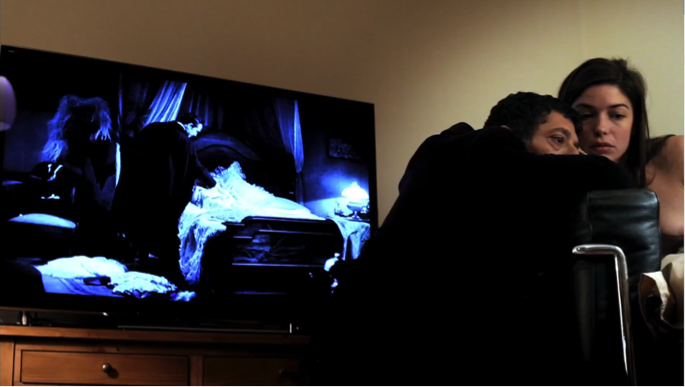
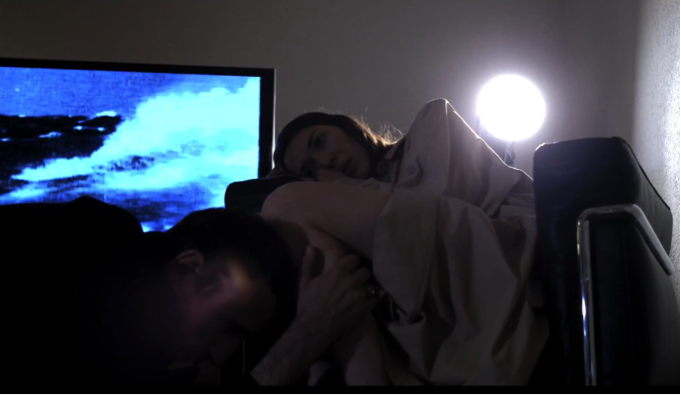
For the second dimension is the dimension of the image as such, where lines proliferate and intersect, shapes emerge, and the lineaments of desire stabilise around figures and forms inherited from what Rancière calls the ‘representational regime’. It is the dimension of painting, of television, of ‘fatal beauty’ (as the Histoire(s) du Cinéma nominates this realm), and perforce of cinema as such: quadrilateral, perspectival in a conventional illusionistic sense, flat, deprived of everything that this work is calling out for and offering in its visual plenitude and depth – a third dimension, that is always in the process of arriving and intersecting with the lifeless two-dimensionality of the nature morte in which the couple is helplessly ensnared, and which only needs to be hailed by them to irradiate their moral darkness. As Godard’s voice croaks in the epilogue, over an image of a watercolour set, “The difficulty lies in representing depth on a flat surface.” Exactly. But here only one agent can make that possible; and it is not a human one.
IV Roxy
Godard’s first 3D work is perversely interested in visual phenomena that exacerbate the inherent problems of the process. By dwelling at very close proximity on subjects such as a leaf-strewn pond reflecting light simultaneously from its painted bottom and the rippling surface; a rain-slickened road by day or night with the surface sheen and reflected image at different focal depths; a group of passengers aboard a ferry seen through Perspex on which glaring solar reflections are lashed; windshield wipers flicking rain or snow off the streaking glass; an active TV screen on which some background light is reflected – and many more besides – Godard is angling for inevitable discrepancies between the distinct patterns of refracted light being focused by each of the two lenses, which the viewer then perceives as a jarring discordancy in the synthetic image. It is an approach further radicalized by the apparent fact that “Godard hasn’t used the converging-lens method to create 3D during shooting. Instead of ‘toeing-in’ his cameras, he set them so that the lenses are strictly parallel.” [15] The distinct ‘squareness’ of the camera angling heightens the sense of an alien phenomenology at work here, a point of view we are obliged to adopt at some cost to our own habitual reflexes. This experience is at once discomfiting, since it makes patent the limitations of the medium, and oddly exhilarating, since it discovers in a process most often used to redouble or reaffirm the protocols of ‘realism’ a capacity for striking, autonomous aesthetic grace-notes.
Godard also looks for extreme depth of field effects, of the kind that any newly converted 3D enthusiast in the commercial sector might have been advised to avoid: objects reaching so far out of the frame that to focus on their protuberance means losing the rest of the image in a blur of double-exposure, or vice versa; extreme planar recessions that the eye finds itself ill-prepared to negotiate given the director’s casual indifference to protocols of gradual accommodation; and occasional radical distortions of the visual field, as we shall see shortly. But neither does the 3D process leave the human body unchanged: delivered from the flatlands of conventional cinematography – which, like painting, has to compress the human figure in amongst all the other visual signs of its framed two-dimensional surfaces – it takes on an alarmingly vulnerable salience, obliged now to hazard its rounded features in a space unmoored from any ground. The volumetric spatiality of the 3D screen discovers in the human body a tender susceptibility to the world receding from it in all directions; a poignant smallness and delicacy impossible to configure on the flat screen (or a screenshot), rendered best, at the work’s gentlest moment, in a tableau of two children rolling dice on the pavement.
Yet the edge toward which the antagonisms of the couple drive this process is the most alarming of all. For on two occasions, the right lens swings unexpectedly wide, losing any directional correspondence with the left, and completes an autonomous pan right to follow Ivitch while the other dwells with, first, Davidson, and second, her companion at home. The resulting visual discord is the limit to which the process can be taken: perfectly discontinuous images reserved for each eye, straining at the brain’s capacity to assimilate and synthesize what, phenomenologically, ought to be ‘one’ continuous image. That each such ‘shot’ (really two superimposed shots taking advantage of the selective screening principle on which the process is based) then culminates in a return to harmony and synthesis only tends to underline the trauma of the experience, since the storied ‘retention of vision’ seems to last longer when this kind of damage is inflicted, not on the retina, but on the brain’s habitual and automatic functions of stereoptic integration. This is the effective return of the second dimension within the frame of the third: for, deprived of the ability to draw ‘depth’ out of these two discontinuous images, the faculty of sight collapses into the flimsiest superficiality. A new extremity of depthlessness, of mere surface appearance, supervenes over the image, establishing a well-nigh ontological connection with those flatscreen television sets within the mise-en-scène, and performing in the most radical way the crisis of the Two, the couple, as a crisis of two-dimensionality in the image and the frame.
It is thus, finally, that Roxy’s itinerary in both versions of the narrative – LA NATURE and LA MÉTAPHORE – arrives as the sole redemptive vector, offering to restore depth and the pregnancy of the image to what is always threatening to fall into a nature morte or a Cubistic aesthetic of exaggerated flatness. The third dimension in this work does not belong to the Two, by definition, and certainly not to the One, but to an unanticipated third party, a stray bitch, who brings with her the entire ‘natural’ cosmos teeming and roiling beyond the narrow confines of plot, desire, and characterology. She it is in whom ‘nature’ and ‘metaphor’ are not related by the verb ‘to be’ (that great anathema of the central section of Film Socialisme) but by the Deleuzian copula ‘and … and … and’. And it is for her that the screen discloses its most sacred compositions and colorations, in hallowed depth, in all those framings that belong to no human point of view. These shots – of dirt tracks, copses, culverts, forests (the word forest is allied, twice, to the ‘origine du monde’ made infamous by Gustave Courbet, and thus to the vaginal principle of a world that is not One), brooks, rivers, trees in holy foliation, lakesides, bushes, shrubs, and the dense weave of matting on the forest floor – are the signs and tokens in Adieu au langage of a properly Heideggerian ‘open’, from which, however, the human being is radically excluded. Indeed, the Heideggerian formula is inverted: the human, locked in a two-dimensional plot, is the one truly ‘poor in world’, while the roaming bitch, sensitive to every sound and scent, is alone capable of ‘world disclosure’ in its fullest and most radical sense. Her innocence of language is, of course, the guarantee of this naked exposure to Being – an innocence Godard ironically and impossibly asks us to recapture, even as he asks his camera to give us a glimpse of what it might look like.
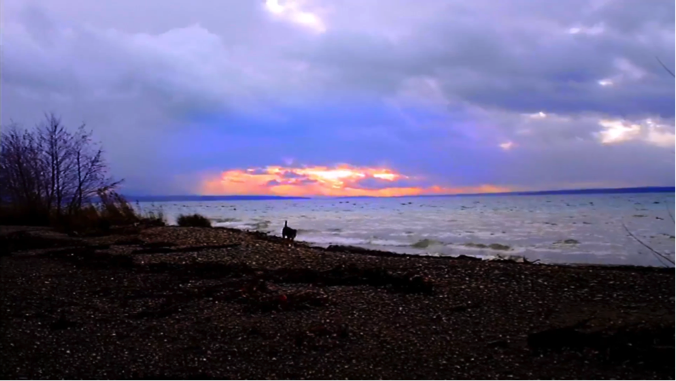
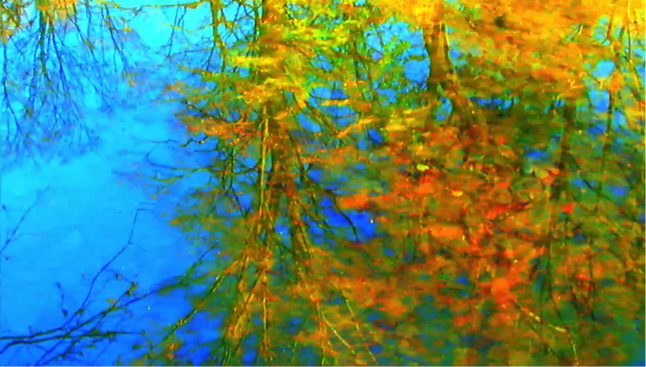
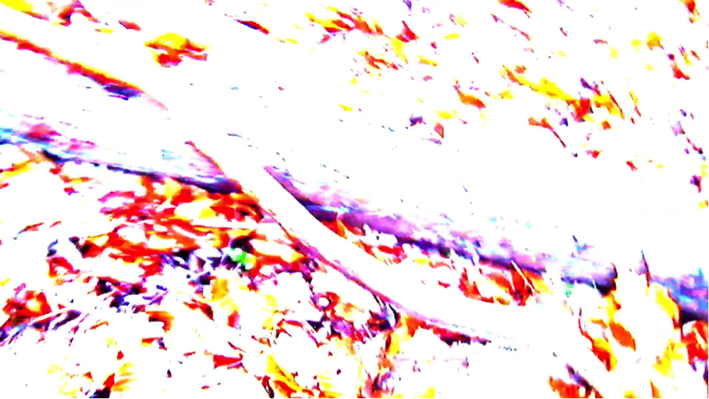
The Rilkean formula underwriting these rhapsodic apostrophes to Beauty is the time-honored one, from the eighth Duino Elegy:
Mit allen Augen sieht die Kreatur
das Offene. Nur unsre Augen sind
wie umgekehrt und ganz um sie gestellt
als Fallen, rings um ihren freien Ausgang.
Was draußen ist, wir wissens aus des Tiers
Antlitz allein; den schon das frühe Kind
wenden wir um und zwingens, daß Offne, das
im Tiergesicht so tie fist. Frie von Tod.
With all its eyes the natural world looks out
into the Open. Only our eyes are turned
Backward, and surround plant, animal child
like traps, as they emerge into their freedom.
We know what is really out there only from
the animals gaze; for we take the very young
child and force it around, so that it sees
objects – not the Open, which is so
deep in animals’ faces. Free from death. [16]
The film as a whole has been working in the redoubtable Formalist way of ostranenie (or estrangement) towards an approximation of what the world might look like to a creature ‘who loves us more than it loves itself’ (as Godard quotes Charles Darwin quoting Josh Billings, as quoted by Dr. Lauder Lindsay), and what we might see as well if only we could love it back – admit the alien third into the intimate space of the Two and so turn it inside out, exposing its limits and collapsing them simultaneously in the giddy rush of a new dimension. The bitch is the test of the couple, a test it seems to fail, twice. We are witnesses to that failure, and to its disappointment, but also to its momentary transfiguration as a felt utopia – the world the couple glimpses before relapsing into its flatland imprisonment and the ‘usine à gaz’ of its creaking plot devices. In much the same way, Virginia Woolf once wrote the biography of Elizabeth Barrett Browning in the form of the biography of her spaniel, Flush. What matters in either case is the unexpected disclosure of an ‘openness’ around the conventional human frame:
The cool globes of dew or rain broke in showers of iridescent spray about his nose; the earth, here hard, here soft, here hot, here cold, stung, teased and tickled the soft pads of his feet. Then what a variety of smells interwoven in subtlest combination thrilled his nostrils; strong smells of earth, sweet smells of flowers; nameless smells of leaf and bramble; sour smells as they crossed the road; pungent smells as they entered bean-fields. But suddenly down the wind came tearing a smell sharper, stronger, more lacerating than any — a smell that ripped across his brain stirring a thousand instincts, releasing a million memories — the smell of hare, the smell of fox. Off he flashed like a fish drawn in a rush through water further and further. He forgot his mistress; he forgot all humankind. [17]
The cinema, however, cannot forget. ‘We will need a child’, the man insists in Adieu au langage, touched by this outside. ‘Or a dog’, she replies. A creature, at any rate, like the creature Mary Wollstonecraft Godwin – soon to be Shelley – gave to Victor Frankenstein and Elizabeth, his betrothed, not naturally, but as a devious literary metaphor. A creature, much like cinema, born the bastard offspring of industrialisation and revolution on the shores of Lake Geneva and wandering the world ever since, looking for a home, a world to call its own, and a companion to make it with. It speaks in a language it has learned from Milton and the Romantics, yet in its mouth that tongue is not our own. If we hear it speak, imploring us to stop and give it and the future their due, we hear only the howling of the wind and the rustling of the forest. Adieu au langage.
Endnotes
[1] The credits at the end read Roxy Miéville.
[2] Adrian Martin, “Recital: Three Lyrical Interludes in Godard,” in For Ever Godard, eds. Michael Temple, James S. Williams and Michael Witt (London: Black Dog, 2004), p. 252.
[3] Jacques Rancière, “Godard, Hitchcock, and the Cinematographic Image,” in For Ever Godard, p. 224.
[4] See here Theodor W. Adorno, In Search of Wagner, (London: Verso, 2005) and Mahler: A Musical Physiognomy (Chicago: University of Chicago Press, 1996).
[5] Alain Badiou, Handbook of Inaesthetics (Stanford: Stanford University Press, 2005), pp. 78-88.
[6] Quoted in Darrell Fasching, The Thought of Jacques Ellul: A Systematic Exposition (Lewiston: Edwin Mellon Press, 1981), p. 17.
[7] Harun Farocki and Kaja Silverman, Speaking about Godard (New York: New York University Press, 1998), p. 186.
[8] Rancière, “Godard, Hitchcock and the Cinematographic Image”, p. 231.
[9] See Jocelyn Benoist, Concepts: Introduction à l’analyse (Paris: CERF, 2010), pp. 1-9.
[10] Alain Badiou, The Century (Cambridge: Polity Press, 2007), pp. 48-57.
[11] Badiou, Being and Event (London: Continuum, 2005), p. 24.
[12] Georges Bataille, “The History of Eroticism” in The Accursed Share, Vol II and III (New York: Zone Books, 1993), p. 160.
[13] Slavoj Zizek, Lacan: The Silent Partners (London: Verso, 2006), p. 252.
[14] Farocki and Silverman, Speaking about Godard, pp. 89-90.
[15] David Bordwell, “Say Hello to Goodbye to Language”, Observations on Film Art, 2 November 2014 http://www.davidbordwell.net/blog/2014/11/02/say-hello-to-goodby-to-language
[16] Rainer Maria Rilke, “The Eighth Elegy”, in The Selected Poetry of Rainer Maria Rilke (London: Picador, 1987), pp. 192-193.
[17] Virgina Woolf, Flush: a biography, https://ebooks.adelaide.edu.au/w/woolf/virginia/w91f/complete.html
